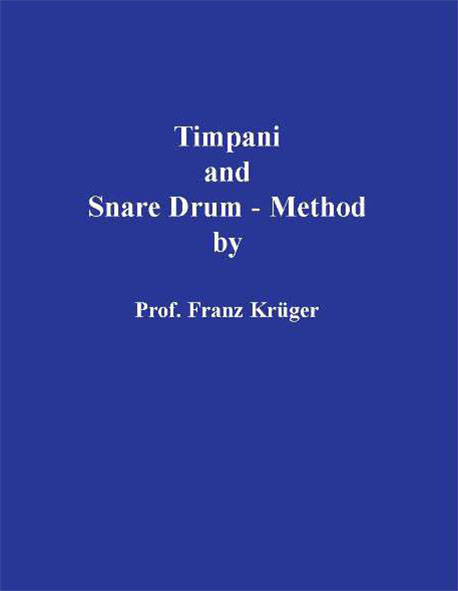
Timpani and Snare Drum-Method including Orchestral Studies by Prof. Franz Krüger
Leu-Vlg Wolfgang Leupelt (Verlag)
978-3-89775-159-0 (ISBN)
Prof. Franz Krüger was born on 9. Dezember 1880 in Rosslau, (today Dessau) Germany. He was the first and solo timpanist with the State Opera Berlin as well as profsessor at the Staatlich Akademische Hochschule für Musik (State Academic College of Music, today Unversity of Arts) in Berlin from 1921 since 1940. Some of his wellknown students: Gerassimos Avgerinos - Solopauker Berliner Philharmoniker Walter Bender - Schlagzeuger Deutsche Staatsoper Berlin Kurt Engel - Solopauker RSO Berlin Friedemann Habner - Solopauker Städtische (später Deutsche) Oper Berlin Hans Hansen - Schlagzeuger/Pauker Berliner Philharmoniker Fritz Reuter - Schlagzeuger RSO Berlin Kurt Schiementz - Solopauker RSO Berlin Rudi Schreiber - Schlagzeuger Komische Oper Berlin Kurt Ulrich - Schlagzeuger Berliner Philharmoniker Kurt Zerbe - Schlagzeuger Städtische Oper Berlin... and much more
2 Preface Kurt Ulrich / Kurt Schiementz
8 Introduction to the Timpani Method
13 Beginning Exercises for Timpani
27 Orchestral Studies for Timpani
162 Introduction to the Snare Drum Method
163 Beginning Exercises for Snare Drum
170 Exercises for Snare Drum
173 Exercises for Bass and Snare Drum
179 Orchestral Studies for Snare Drum
204 Introduction for the Glockenspiel and Xylophone
205 Exercises for Xylophone
206 Orchestral Studies for Xylophone
214 Orchestral Studies for Glockenspiel
Prof. Franz Krüger, first and solo timpanist with the State Opera Berlin as well as professor at the Staatlich Akademische Hochschule für Musik (State Academic College of Music) in Berlin, died unexpectedly in June of 1940. Due to his sudden death, my desire to have Prof. Krüger's collection of orchestral studies as well as the practical exercises for timpani and snare drum published in one comprehensive volume remained unfulfilled. Subsequently, Krüger's wife entrusted me to proceed with the compilation of his study materials. I commenced this project with great pleasure. As a former student of Prof. Krüger, this was a way to pay tribute to our teacher. Since this method book is not suitable for self-study, but is intended for guided studies with an instructor, I have omitted all information about the historical development of the timpani, e.g. the differences between hand-tuning by means of screws and taps, as well as pedal-tuning. Furthermore, definitions of elementary music terms have been waived as well. Since the student is supposed to be under regular supervision by an instructor, I have occasionally left out the sticking and timpani positioning in some studies on purpose. Here, the student is encouraged to figure this out by himself. Due to the abundance of materials, it was only possible to document the most important orchestral studies. Longer rests or skips over less important passages are marked in the timpani part with multiple strokes (///) or /---/. Finally, I would like to thank Mrs. Krüger for trusting me in putting together the work of Professor Krüger. Berlin, December of 1942 Kurt Ulrich
Prof. Franz Krüger, first and solo timpanist with the State Opera Berlin as well as professor at the Staatlich Akademische Hochschule für Musik (State Academic College of Music) in Berlin, died unexpectedly in June of 1940.Due to his sudden death, my desire to have Prof. Krüger's collection of orchestral studies as well as the practical exercises for timpani and snare drum published in one comprehensive volume remained unfulfilled.Subsequently, Krüger's wife entrusted me to proceed with the compilation of his study materials. I commenced this project with great pleasure. As a former student of Prof. Krüger, this was a way to pay tribute to our teacher. Since this method book is not suitable for self-study, but is intended for guided studies with an instructor, I have omitted all information about the historical development of the timpani, e.g. the differences between hand-tuning by means of screws and taps, as well as pedal-tuning. Furthermore, definitions of elementary music terms have been waived as well.Since the student is supposed to be under regular supervision by an instructor, I have occasionally left out the sticking and timpani positioning in some studies on purpose. Here, the student is encouraged to figure this out by himself.Due to the abundance of materials, it was only possible to document the most important orchestral studies. Longer rests or skips over less important passages are marked in the timpani part with multiple strokes (///) or /---/.Finally, I would like to thank Mrs. Krüger for trusting me in putting together the work of Professor Krüger.Berlin, December of 1942Kurt Ulrich
| Erscheinungsdatum | 08.10.2016 |
|---|---|
| Überarbeitung | Kurt Schiemenz |
| Sprache | englisch |
| Maße | 210 x 300 mm |
| Gewicht | 950 g |
| Einbandart | gebunden |
| Themenwelt | Kunst / Musik / Theater ► Musik ► Instrumentenunterrricht |
| Schlagworte | Musik: Musizieren, Techniken, Anleitungen • Snare Drum studies with orchestral studies • study materials for Timpani and Snaredrum with orchestral studies • Xylpohone studies with orchestral studies |
| ISBN-10 | 3-89775-159-3 / 3897751593 |
| ISBN-13 | 978-3-89775-159-0 / 9783897751590 |
| Zustand | Neuware |
| Haben Sie eine Frage zum Produkt? |
aus dem Bereich


